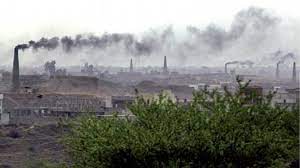Once known for its scenic beauty, habitat and natural streams, the federal capital has been fast losing its elegance due to unruly population and housing societies growth threatening its ecosystem and serenity.
Its natural streams flowing out of perennial and seasonal springs of the Margalla Hills have turned into filthy and stinky drains as city manager had failed to put in place proper waste disposal mechanism.
Rapid growth in population and massive construction in catchment areas continued to pollute streams emanating unpleasant odor throughout the city, besides turning brooks into breeding habitats of mosquitoes.
The Captial homes about 26 small and large streams, passing through the hill torrents embracing rainwater and tossing over different residential sectors finally converging into two main streams outside Islamabad.
“Due to discharge of domestic waste and leakage of municipal sewers, these streams are highly polluted and spew foul odour and breed mosquitoes,” says an official of Pakistan Environment Protection Agency (Pak-EPA).
“This is a continuous threat to capital’s environment, habitat and human health. Therefore, there is dire need to focus this dilemma,” the official said.
In the initial master plan of Islamabad, the natural streams were left open with large spaces on both sides to make them flow smoothly along their natural courses. Later on, the encroachments were built by narrowing them to create space for residential and commercial plots.
Overflowing choked sewerage lines and plastic waste dumping into nullahs besides poor waste management as the citizens, Capital Development Authority and Islamabad
Metropolitan Corporation had seemingly failed to fulfill their responsibilities.
“It was our collective responsibility. But, on one side citizens showed negligence in keeping these tributaries clean and one the other side the city managers failed to put in place proper waste disposal system,” said a CDA official.
“If you observe the tributaries of these various drains they show pure and crystal clear water, but they become dirty and smelly while passing through the human settlements,” the official said on condition of anonymity.
“At some spots, sewage water flows directly into natural streams thanks to broken lines. It becomes worse at night,” he added.
The information with CDA also reveals that initially rainwater and sewage drains were laid separately. But, later on completion certificates were issued to house least caring for this principle.
“Such actions encouraged people and they stopped laying separate lines for sewage and rainwater to save meager cost of pipelines and started discharging sewage into rain drains,” the official informed.
Just to talk of sewage treatment plants, there is one sewage treatment plant (STP) functional in sector I-9 treating up to six million gallons sewage per day (mgd) against its total capacity of 14 mgd due to broken network of sewage supply lines in various sectors. If running on full capacity, this plant can provide ample amount of water for horticulture in capital.
Deputy Director General Water CDA Sardar Khan Zimri has said funds were allocated for improving the network of trunk lines for the smooth flow of sewage to the STP.“Once the broken lines are repaired, we will receive almost 10-12mgd of sewage for treatment.”
There are also reports that in absence of STPs, untreated water from localities in the catchment areas was mixing with water coming to Rawal Dam, exposing residents of twin cities to serious health hazards.
The Supreme Court sometimes back, in a suo motu notice on water contamination, had directed installation of STPs. Although, the civic agency in light of this order tried to establish STPs in catchment areas like Shahdara, Bari Imam and near Banigala, but this approximately Rs3.9 billion project could not take off .
“This project remained in limbo for the last several years due to one reason or the other,” said another official. “When this project starts, it will require 14 months to complete and able to treat 9.6 million gallons of untreated water daily.”
According to CDA, a PC-I was prepared on the direction of Planning Commission as an Engineering Procurement and Construction (EPC) project. After, awarding the tender, the civic body approached for a revised PC-I’s approval. The same time Pak-EPA raised an objection that environmental impact assessment (EIA) for the project was not carried out.
Meantime, the bid’s validity period expired.
Now the civic agency has approached the Planning Commission through the interior
ministry seeking guidance as how to move forward with the project. The CDA has informed the Planning Commission that EIA could not be conducted for a project being carried out through the EPC mode.
The CDA has also proposed the Planning Commission to allow project execution without the EPC mode so the civic body could get the environmental assessment impact conducted before the contract was awarded.
Meanwhile, keeping in view the worsening situation, the government has earmarked Rs200 million in annual budget for year 2022-23 for establishment of Korang River and Rawal lake water treatment plants.
Since, a meager amount of waste water is treated in our country there is dire need to make waste water usable at least for irrigation because fast depleting glacial and underground water resource would be landing us in a serious trouble.






















